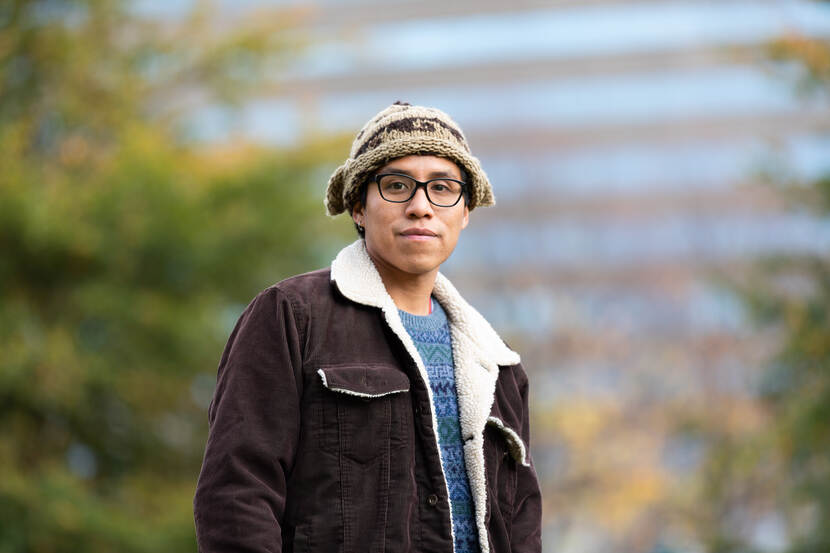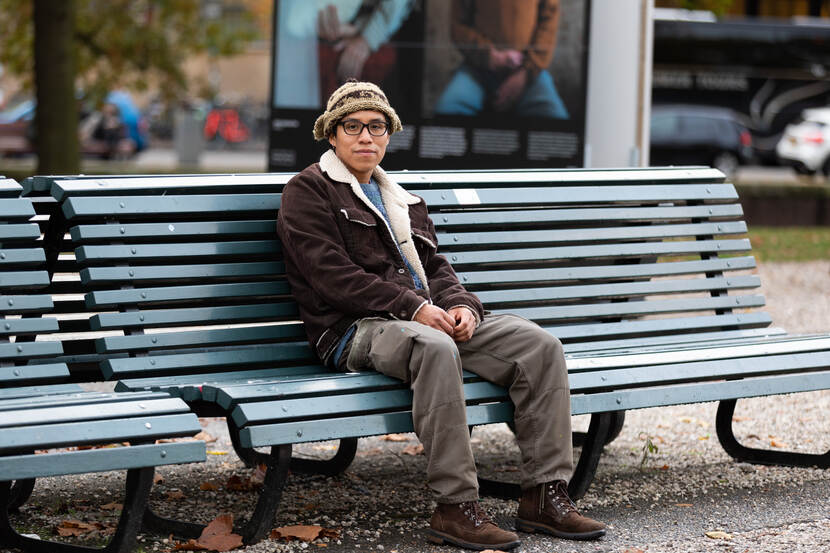Peruvian photojournalist Atoq finds safe haven in Shelter City The Hague
In 2017, while photographing demonstrators in Lima, Atoq was struck in the eye by a rubber bullet fired by police. Now, after years of fighting for justice, the Peruvian photojournalist has begun a three-month residency in The Hague under the Shelter City programme. The programme sees the organisation Justice & Peace offer temporary shelter to human rights defenders, with the support of the Dutch Ministry of Foreign Affairs. ‘Only now that there’s some distance between me and what happened, am I starting to understand the impact of violence,’ says Atoq, now 30.
‘I could see from the shock on people’s faces, that it was bad,’ Atoq recalls. He did not feel pain as the bullet pierced his eye. Everything went black and he fell on his back. Those nearby bent over him, and the only thing he felt was something warm flowing over his cheek.
It’s been four years since the incident, when police officers trained their weapons on him multiple times as he pointed his camera at wounded demonstrators. But despite subsequent intimidation, he continues to photograph victims of police violence, resolute in his determination to fight for justice. It is a drive that has cost him dearly over the years.
A sense of justice is something that has been instilled in Atoq since birth. His mother is Quechua, a people indigenous to Peru who have been discriminated against since the Spanish colonisation. Indígenas who pursue higher education are rare, but his mother managed to attend university alongside her work as a housekeeper. She taught her son to think critically.
Poverty and social inequality
Atoq began his photography career with street photography, using a borrowed camera. ‘I wanted to show what reality looks like: poverty and social inequality. In the hope that the people would ask themselves whether it was really true that the gap between poor and rich is so big.’ He had been studying anthropology, but turned away from that field after winning a scholarship to study photography.
After graduating, he began working as an intern at a daily newspaper. On 5 January 2017, his supervisor sent him to a demonstration that was expected to turn violent. ‘In Peru, you can’t send interns to high-risk situations; there’s a law against that, because they’re not insured. Besides which, I had no bulletproof vest or helmet.’ But he went anyway, because he wanted to show the world what was happening during demonstrations in his country.
Losing an eye
And when things went wrong, Atoq did indeed have a real problem. The hospital did not want to help him because he had no healthcare insurance. ‘You need to brace yourself, you’re probably going to lose your eye,’ the doctor told him. It was a hard message to hear. And where could he possibly find the money for an eye operation? The local paper he worked for turned its back on him, declining to offer any support. And the police claimed that they didn’t fire the shot. ‘It’s crazy; the demonstrators didn’t have any weapons at all, and I have photos as proof.’
Thanks to family and friends, he was able to travel to a specialist clinic in Miami. There, he was told that leaving the bullet where it was would give him the best chance of saving some of the vision in his eye. In search of justice, Atoq turned to the media. After a newspaper ran the story, his employer ultimately paid for the first of four eye operations. ‘The police said they were going to close the case for lack of evidence.’
With the help of a Peruvian human rights organisation, however, he gained access to internal police plans. ‘They show exactly how many vehicles and police personnel were there on the day of the demonstration. But the police said that the license plates in my pictures don’t belong to their vehicles.’ After all the time that has passed, Atoq has still not been able to get justice. ‘I had hoped that at the very least, the Peruvian government would compensate me for the treatments for my PTSD, or at least offer an apology.’
Young photographers collective
After a year, Atoq took up photography again. Although he now stays away from the front lines, he keeps the struggle for justice alive in his work. In November 2020, Manuel Merino emerged as new interim president with the backing of a rich and conservative faction in congress but without the backing of the people. A wave of demonstrations once again swept the country and two young protesters – one aged 21, the other aged 24 – were killed. Both were good friends of Atoq. ‘With the deaths of Inti and Brian, the fear spread even further. It was like if coronavirus didn’t get you, the police would.’
Atoq began phoning other young photographers, with a message: we have to organise, because no one is protecting us. A collective spontaneously arose: Fotografos Autoconvocados (FAC). ‘Now we only go out into the streets in pairs, and the coordinator keeps track of where everyone is and whether everyone is safe.’
‘We’re risking our lives to take on injustice, but without compensation, resources or protection.’
Tribute to fallen friends
After five days of protests, Merino stepped down. As a tribute to their fallen friends, the collective stuck huge photos on walls, invited musicians to perform and engaged with local residents to talk about intimidation. On the internet, they published a practical guide giving tips on what to do if you are arrested during a demonstration. The police began tailing the photographers of the collective. One Peruvian human rights organisation advised them to leave Lima for their own safety. Atoq fled to Cuzco, but could not stay there long due to a lack of income.
He returned to Lima, but with concerns: what if something happens? ‘We’re risking our lives to take on injustice, but without compensation, resources or protection. And there’s a new law in place, which says that police will not be prosecuted if they shoot someone in self-defence.’
Shelter City
It was then that human rights organisation Justice & Peace invited Atoq to take part in a programme that would allow him to reside in The Hague for three months. The programme, Shelter City, is made possible in part with the support of the Dutch Ministry of Foreign Affairs. Atoq jumped at the chance. ‘A Dutch specialist is monitoring my eye, and I’m also seeing a psychologist here. It’s only now that I realise I had never devoted any attention to my mental health. I had always seen exposure to violence as being a part of my work. Now that I have some distance from the situation, I’m starting to become aware of how much impact it has had on me. It’s something I wish I could share with every activist.’
Atoq is also using the three months to prepare himself for his return. ‘This is the first time that I’ve made contacts with international human rights organisations and artists. I want to organise an exhibition here to call attention to what is happening in Peru. For the 12 people of my collective - nine men and three women - there’s two things I want to achieve. First, I hope that they can also get access to mental healthcare like I have. And secondly, I hope I will be going back with bulletproof vests, safety glasses and helmets, so we will be able to do our work safely.’
*Atok is a nickname that means ‘fox’ in Quechua. ‘I see myself like Robin Hood; a fox that steals chickens to feed the poor with.’
Shelter City programme
The Shelter City programme offers at-risk human rights defenders the chance to stay for three months in a safe setting where they can re-energise, expand their network and build their knowledge. The programme is active in 12 Dutch cities and eight cities in other countries. At the World Press Freedom Conference in 2020, the Netherlands announced that it was expanding the Shelter City programme by adding two extra places per year intended specially for journalists. Atoq’s place in Shelter City The Hague is one of these.

